-

新人教版高中英语选修2Unit 2 Reading for writing教学设计
The theme of this section is to express people's views on studying abroad. With the continuous development of Chinese economic construction, especially the general improvement of people's living standards, the number of Chinese students studying abroad at their own expense is on the rise. Many students and parents turn their attention to the world and regard studying abroad as an effective way to improve their quality, broaden their horizons and master the world's advanced scientific knowledge, which is very important for the fever of going abroad. Studying abroad is also an important decision made by a family for their children. Therefore, it is of great social significance to discuss this issue. The theme of this section is the column discussion in the newspaper: the advantages and disadvantages of studying abroad. The discourse is about two parents' contribution letters on this issue. They respectively express their own positions. One thinks that the disadvantages outweigh the advantages, and the other thinks that the advantages outweigh the disadvantages. The two parents' arguments are well founded and logical. It is worth noting that the two authors do not express their views on studying abroad from an individual point of view, but from a national or even global point of view. These two articles have the characteristics of both letters and argumentative essays1.Guide the students to read these two articles, and understand the author's point of view and argument ideas2.Help the students to summarize the structure and writing methods of argumentative writing, and guides students to correctly understand the advantages and disadvantages of studying abroad3.Cultivate students' ability to analyze problems objectively, comprehensively and deeply

新人教版高中英语选修2Unit 2 Using langauge-Listening教学设计
? B: Absolutely! Getting involved with Chinese cultural activities there definitely helped a lot. I got to practice my Chinese on a daily basis, and I could learn how native Chinese speakers spoke.? A: What do you feel is your biggest achievement?? B: Learning Chinese characters! I have learnt about 1,500 so far. When I first started, I didn't think it was even going to be possible to learn so many, but now I find that I can read signs, menus, and even some easy newspaper articles.? A: What are you most keen on?? B: I've really become keen on learning more about the Chinese culture, in particular Chinese calligraphy. As I have learnt Chinese characters, I have developed a great appreciation for their meaning. I want to explore Chinese characters by learning how to write them in a more beautiful way. ? A: Finally, what do you want to say to anyone interested in learning Chinese?? I have really become keen on learning more about the Chinese culture, in particular Chinese Calligraphy. As I have learnt Chinese character, I have developed a great appreciation for their meaning. I want to explore Chinese characters by learning how to write them in a more beautiful way.? A: Finally, what do you want to say to anyone interested in learning Chinese?? B: I'd say, give it a shot! While some aspects may be difficult, it is quite rewarding and you will be happy that you tried.? A: Thanks for your time. ? B:You're welcome.

新人教版高中英语选修2Unit 3 Using langauge-Listening教学设计
1. How is Hunan cuisine somewhat different from Sichuan cuisine?The heat in Sichuan cuisine comes from chilies and Sichuan peppercorns. Human cuisine is often hotter and the heat comes from just chilies.2.What are the reasons why Hunan people like spicy food?Because they are a bold people. But many Chinese people think that hot food helps them overcome the effects of rainy or wet weather.3.Why do so many people love steamed fish head covered with chilies?People love it because the meat is quite tender and there are very few small bones.4.Why does Tingting recommend bridge tofu instead of dry pot duck with golden buns?Because bridge tofu has a lighter taste.5 .Why is red braised pork the most famous dish?Because Chairman Mao was from Hunan, and this was his favorite food.Step 5: Instruct students to make a short presentation to the class about your choice. Use the example and useful phrases below to help them.? In groups of three, discuss what types of restaurant you would like to take a foreign visitor to, and why. Then take turns role-playing taking your foreign guest to the restaurant you have chosen. One of you should act as the foreign guest, one as the Chinese host, and one as the waiter or waitress. You may start like this:? EXAMPLE? A: I really love spicy food, so what dish would you recommend?? B: I suggest Mapo tofu.? A: Really ? what's that?

新人教版高中英语选修2Unit 4 Learning about Language教学设计
This section guides students to pay attention to the typical context of vocabulary use, helps students accumulate vocabulary around the key vocabulary of this unit, and uses the learned words and word chunks in different contexts to deeply understand their meaning and usage, so as to achieve the purpose of review and consolidation.The teaching design activities aim to guide students to pay attention to the typical context in which the target vocabulary is used, as well as the common vocabulary used in collocation, so that students can complete the sentence with correct words. In terms of vocabulary learning strategies, this unit focuses on cultivating students' ability to pay attention to collocation of words and to use word blocks to express meaning.For vocabulary learning, it is not enough just to know the meaning of a single word, but the most important thing is to master the common collocations of words, namely word blocks.Teachers should timely guide students to summarize common vocabulary collocation, such as verb and noun collocation, verb and preposition collocation, preposition and noun collocation, and so on.1. Guide students to understand and consolidate the meaning and usage of the vocabulary in the context, 2. Guide the students to use the unit topic vocabulary in a richer context3. Let the students sort out and accumulate the accumulated vocabulary, establishes the semantic connection between the vocabulary,4. Enable students to understand and master the vocabulary more effectivelyGuiding the Ss to use unit topic words and the sentence patterns in a richer context.

新人教版高中英语选修2Unit 4 Reading for writing教学设计
假定你是英国的Jack,打算来中国旅行,请你给你的中国笔友李华写一封信,要点如下:1.你的旅行计划:北京→泰山→杭州;2.征求建议并询问他是否愿意充当你的导游。注意:1.词数80左右(开头和结尾已给出,不计入总词数);2.可以适当增加细节,以使行文连贯。参考词汇:故宫 the Forbidden City;泰山 Mount TaiDear Li Hua,I'm glad to tell you that 'm going to visit China.First,I am planning to visit Beijing,the capitalof China,where I am looking forward to enjoying the Great Wall,the Forbidden City and somebeautiful parks.Then I intend to go to visit Mount Tai in Shandong Province.I've heard that it is one ofthe most famous mountains in China and I can't wait to enjoy the amazing sunrise there.After that,I amalso going to Hangzhou.It is said that it is a beautiful modern city with breathtaking natural sights,among which the West Lake is a well- known tourist attraction.What do you think of my travel plan? Will you act as my guide? Hope to hear from you soon.

新人教版高中英语选修2Unit 4 Using langauge-Listening教学设计
The theme of the listening section is " talking about scenery and culture along a journey."The part is designed to further lead the students to understand Canadian natural geography and social environment, and integrated into the cultural contrast by mentioning the long train journey from Beijing to Moscow routes. On this basis, the part activates students related travel experience, lets the student serial dialogue, guides the student to explore further the pleasure and meaning of the long journey, and Chinese and foreign cultural comparison.The part also provides a framework for the continuation of the dialogue, which is designed to provide a framework for students to successfully complete their oral expressions, and to incorporate an important trading strategy to end the dialogue naturally.1. Help students to understand and master some common English idioms in the context, and experience the expression effect of English idioms.2. Guide the students to understand the identity of different people in the listening context, and finish the dialogue according to their own experience.3. Instruct the students to use appropriate language to express surprise and curiosity about space and place in the dialogue, and master the oral strategy of ending the dialogue naturally.1. Instruct students to grasp the key information and important details of the dialogue.2. Instruct students to conduct a similar talk on the relevant topic.

新人教版高中英语选修2Unit 5 Learning about Language教学设计
The purpose of this section of vocabulary exercises is to consolidate the key words in the first part of the reading text, let the students write the words according to the English definition, and focus on the detection of the meaning and spelling of the new words. The teaching design includes use English definition to explain words, which is conducive to improving students' interest in vocabulary learning, cultivating their sense of English language and thinking in English, and making students willing to use this method to better grasp the meaning of words, expand their vocabulary, and improve their ability of vocabulary application. Besides, the design offers more context including sentences and short passage for students to practice words flexibly.1. Guide students to understand and consolidate the meaning and usage of the vocabulary in the context, 2. Guide the students to use the unit topic vocabulary in a richer context3. Let the students sort out and accumulate the accumulated vocabulary, establishes the semantic connection between the vocabulary,4. Enable students to understand and master the vocabulary more effectivelyGuiding the Ss to use unit topic words and the sentence patterns in a richer context.Step1: Read the passage about chemical burns and fill in the blanks with the correct forms of the words in the box.

新人教版高中英语选修2Unit 5 Reading and thinking教学设计
The theme of this activity is to learn the first aid knowledge of burns. Burns is common in life, but there are some misunderstandings in manual treatment. This activity provides students with correct first aid methods, so as not to take them for granted in an emergency. This section guides students to analyze the causes of scald and help students avoid such things. From the perspective of text structure and collaborative features, the text is expository. Expository, with explanation as the main way of expression, transmits knowledge and information to readers by analyzing concepts and elaborating examples. This text arranges the information in logical order, clearly presents three parts of the content through the subtitle, accurately describes the causes, types, characteristics and first aid measures of burns, and some paragraphs use topic sentences to summarize the main idea, and the level is very clear.1. Guide students to understand the causes, types, characteristics and first aid methods of burns, through reading2. Enhance students’ ability to deal withburnss and their awareness of burns prevention3. Enable students to improve the ability to judge the types of texts accurately and to master the characteristics and writing techniques of expository texts.Guide students to understand the causes, types, characteristics and first aid methods of burns, through readingStep1: Lead in by discussing the related topic:1. What first-aid techniques do you know of ?CPR; mouth to mouth artificial respiration; the Heimlich Manoeuvre

新人教版高中英语选修2Unit 5 Using langauge-Listening教学设计
The theme of this section is to learn how to make emergency calls. Students should learn how to make emergency calls not only in China, but also in foreign countries in English, so that they can be prepared for future situations outside the home.The emergency telephone number is a vital hotline, which should be the most clear, rapid and effective communication with the acute operator.This section helps students to understand the emergency calls in some countries and the precautions for making emergency calls. Through the study of this section, students can accumulate common expressions and sentence patterns in this context. 1.Help students accumulate emergency telephone numbers in different countries and learn more about first aid2.Guide the students to understand the contents and instructions of the telephone, grasp the characteristics of the emergency telephone and the requirements of the emergency telephone.3.Guide students to understand the first aid instructions of the operators.4.Enable Ss to make simulated emergency calls with their partners in the language they have learned1. Instruct students to grasp the key information and important details of the dialogue.2. Instruct students to conduct a similar talk on the relevant topic.Step1:Look and discuss:Match the pictures below to the medical emergencies, and then discuss the questions in groups.
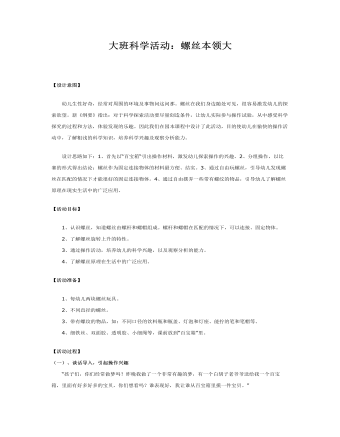
大班科学教案:螺丝本领大
设计思路如下:1、首先以“百宝箱“引出操作材料,激发幼儿探索操作的兴趣。2、分组操作,以比赛的形式得出结论:螺丝作为固定连接物体的材料最方便、结实。3、通过自由玩螺丝,引导幼儿发现螺丝在匹配的情况下才能很好的固定连接物体。4、通过自由摆弄一些带有螺纹的物品,引导幼儿了解螺丝原理在现实生活中的广泛应用。【活动目标】1、认识螺丝,知道螺丝由螺杆和螺帽组成。螺杆和螺帽在匹配的情况下,可以连接、固定物体。2、了解螺丝旋转上升的特性。3、通过操作活动,培养幼儿的科学兴趣,以及观察分析的能力。4、了解螺丝原理在生活中的广泛应用。
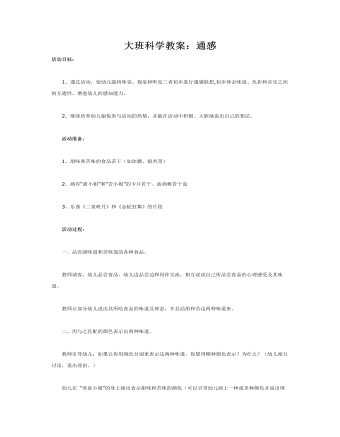
大班科学教案:通感
活动准备: 1、甜味和苦味的食品若干(如冰糖、银杏等) 2、画有“甜小姐”和“苦小姐”的卡片若干、油画棒若干盒 3、乐曲《二泉映月》和《金蛇狂舞》的片段 活动过程: 一、品尝甜味道和苦味道的各种食品。 教师请客,幼儿品尝食品,幼儿边品尝边和同伴交流,相互说说自己所品尝食品的心理感受及其味道。 教师让部分幼儿说出其所吃食品的味道及神态,并总结甜和苦这两种味道来。
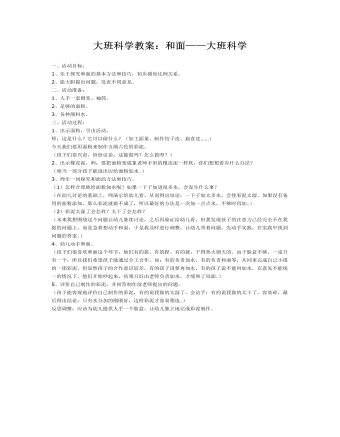
大班科学教案:和面——大班科学
二、活动准备: 1、人手一套围兜、袖筒。 2、足够的面粉。 3、各种颜料水。 三、活动过程: 1、出示面粉,引出活动。 师:这是什么?它可以做什么?(加工面条、制作饺子皮、扁食皮……) 今天我们要用面粉来制作五颜六色的彩泥。 (孩子们很兴奋,纷纷议论:这能做吗?怎么做呀?) 2、出示橡皮泥,师:要把面粉变成象老师手里的橡皮泥一样软,你们想想看有什么办法? (相当一部分孩子能说出应给面粉加水。)
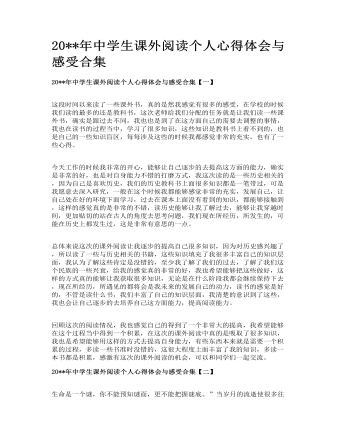
中学生课外阅读个人心得体会与感受合集
总体来说这次的课外阅读让我逐步的提高自己很多知识,因为对历史感兴趣了,所以读了一些与历史相关的书籍,这些知识填充了我很多丰富自己的知识层面,我认为了解这些肯定是没错的,至少我了解了我们的过去,了解了我们这个民族的一些兴衰,给我的感觉真的非常的好,我也希望能够把这些做好,这样的方式真的能够让我获取很多知识,无论是在什么阶段我都会继续保持下去,现在所经历,所遇见的都将会是我未来的发展自己的动力,读书的感觉是好的,不管是读什么书,我们丰富了自己的知识层面,我清楚的意识到了这些,我也会让自己逐步的去培养自己这方面能力,提高阅读能力。
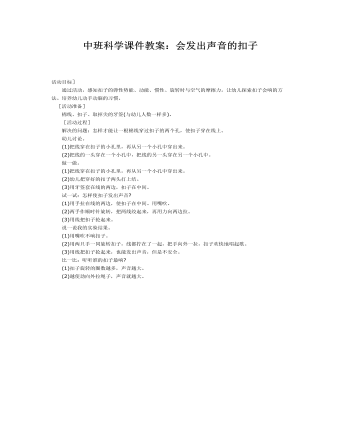
中班科学课件教案:会发出声音的扣子
[活动准备] 棉线、扣子、取掉尖的牙签(与幼儿人数一样多)。 [活动过程] 解决的问题:怎样才能让一根棉线穿过扣子的两个孔,使扣子穿在线上。 幼儿讨论。(1)把线穿在扣子的小孔里,再从另一个小孔中穿出来。(2)把线的一头穿在一个小孔中,把线的另一头穿在另一个小孔中。 做一做。(1)把线穿在扣子的小孔里,再从另一个小孔中穿出来。(2)幼儿把穿好的扣子两头打上结。
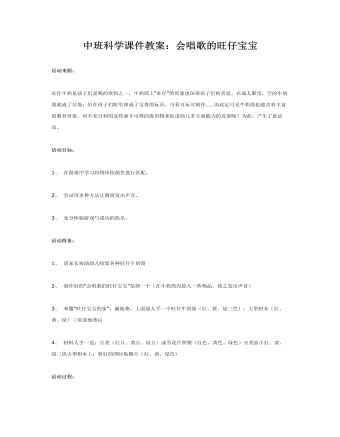
中班科学课件教案:会唱歌的旺仔宝宝
活动目标:1、 在游戏中学习将物体按颜色进行匹配。2、 尝试用多种方法让圆筒发出声音。3、 充分体验游戏与成功的快乐。活动准备:1、 请家长协助幼儿收集各种旺仔牛奶筒2、 制作好的“会唱歌的旺仔宝宝”范例一个(在牛奶筒内放入一些物品,使之发出声音)3、 布置“旺仔宝宝的家”:铺地垫,上面放人手一个旺仔牛奶筒(红、黄、绿三色);大型积木(红、黄、绿)三块放地垫后4、 材料人手一盒:豆类(红豆、黄豆、绿豆)或雪花片积塑(红色、黄色、绿色)分类放于红、黄、绿三块大型积木上;剪好的即时贴圆片(红、黄、绿色)
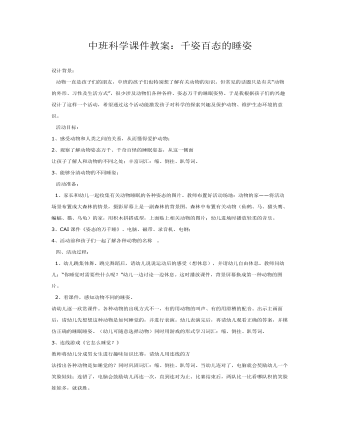
中班科学课件教案:千姿百态的睡姿
活动目标: 1、感受动物和人类之间的关系,从而懂得爱护动物; 2、观察了解动物姿态万千、千奇百怪的睡眠姿态,从这一侧面 让孩子了解人和动物的不同之处;丰富词汇:缩、倒挂、趴等词。 3、能够分清动物的不同睡姿; 活动准备: 1、家长和幼儿一起收集有关动物睡眠的各种姿态的图片。教师布置好活动场地:动物的家——将活动场景布置成大森林的情景,摄影屏幕上是一副森林的背景图。森林中布置有关动物(仙鹤、马、猫头鹰、蝙蝠、猫、乌龟)的家,用积木拼搭成型,上面贴上相关动物的图片;幼儿进场时播放轻柔的音乐。 3、CAI课件《姿态的万千睡》、电脑、磁带、录音机、电钢; 4、活动前和孩子们一起了解各种动物的名称 。
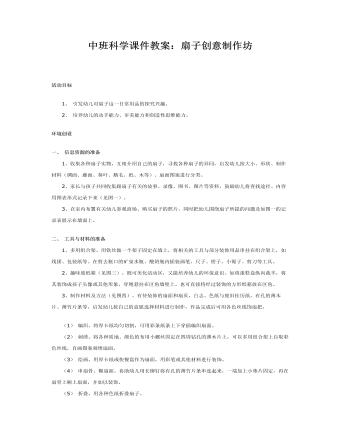
中班科学课件教案:扇子创意制作坊
2、培养幼儿的动手能力、审美能力和创造性思维能力。环境创设一、信息资源的准备1、收集各种扇子实物,互相介绍自己的扇子,寻找各种扇子的异同,启发幼儿按大小、形状、制作材料(绸面、藤面、葵叶、鹅毛、纸、木等)、扇面图案进行分类。2、家长与孩子共同收集跟扇子有关的故事、录像、图书、图片等资料,鼓励幼儿将查找途径、内容用图表形式记录下来(见图一)。3、在室内布置有关幼儿参观商场、购买扇子的照片,同时把幼儿围绕扇子所提的问题及如图一的记录表展示在墙面上。二、工具与材料的准备1、多用组合架。用铁丝做一个架子固定在墙上,将相关的工具与部分装饰用品串挂在组合架上,如线团、包装纸等。在剪去瓶口的矿泉水瓶、酸奶瓶内插装画笔、尺子、钳子、小锯子、剪刀等工具。2、趣味废纸箱(见图三)。既可美化活动区,又能培养幼儿的环保意识。如将蛋糕盒纵向裁半,将其装饰成孩子头像或其他形象,穿绳悬挂在区角墙壁上。也可直接将经过装饰的方形纸箱放在区角。3、制作材料及方法(见图四)。有待装饰的扇面和扇页,白志、色纸与废旧挂历纸,有孔的薄木片、薄竹片条等,启发幼儿按自己的意愿选择材料进行制作,作品完成后可用各色丝线饰扇把。
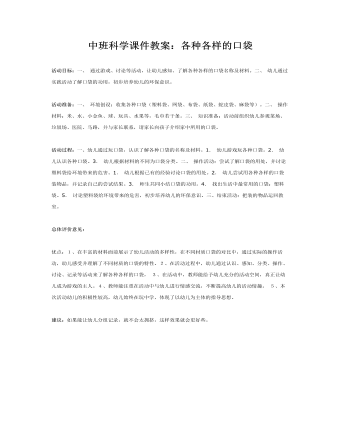
中班科学课件教案:各种各样的口袋
活动准备:一、环境创设:收集各种口袋(塑料袋、网袋、布袋、纸袋、蛇皮袋、麻袋等)。二、操作材料:米、水、小金鱼、球、玩具、水果等,毛巾若干条。三、知识准备:活动前组织幼儿参观菜场、垃圾场、医院、马路,并与家长联系,请家长向孩子介绍家中所用的口袋。 活动过程:一、幼儿通过玩口袋,认识了解各种口袋的名称及材料。1.幼儿游戏玩各种口袋。2.幼儿认识各种口袋。3.幼儿根据材料的不同为口袋分类。二、操作活动:尝试了解口袋的用处,并讨论塑料袋给环境带来的危害。1.幼儿根据已有的经验讨论口袋的用处。2.幼儿尝试用各种各样的口袋装物品,并记录自己的尝试结果。3.师生共同小结口袋的功用。4.找出生活中最常用的口袋:塑料袋。5.讨论塑料袋给环境带来的危害,初步培养幼儿的环保意识。三、结束活动:把装的物品运回教室。
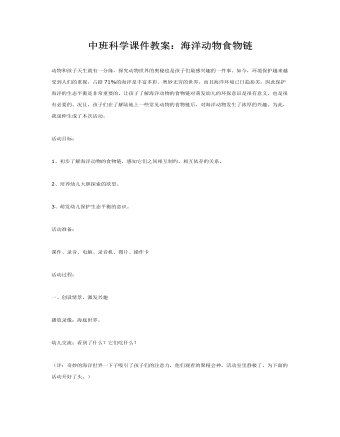
中班科学课件教案:海洋动物食物链
活动目标: 1、初步了解海洋动物的食物链,感知它们之间相互制约、相互依存的关系。 2、培养幼儿大胆探索的欲望。 3、萌发幼儿保护生态平衡的意识。 活动准备: 课件、录音、电脑、录音机、图片、操作卡活动过程: 一、创设情景,激发兴趣 播放录像:海底世界。 幼儿交流:看到了什么?它们吃什么? (评:奇妙的海洋世界一下子吸引了孩子们的注意力,他们观看的聚精会神,活动室里静极了,为下面的活动开好了头。)
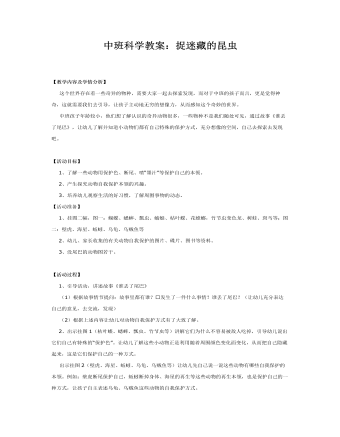
中班科学课件教案:爱捉迷藏的昆虫
【活动目标】 1、了解一些动物用保护色、断尾、喷“墨汁”等保护自己的本领。 2、产生探究动物自我保护本领的兴趣。 3、培养幼儿观察生活的好习惯,了解周围事物的动态。【活动准备】 1、挂图二幅,图一:蝴蝶、蟋蟀、瓢虫、蜻蜓、枯叶蝶、花螳螂,竹节虫变色龙、树蛙、斑马等;图二:壁虎、海星、蚯蚓、乌龟、乌贼鱼等 2、幼儿、家长收集的有关动物自我保护的图片、碟片、图书等资料。 3、没尾巴的动物图若干。 【活动过程】 1、引导活动,讲述故事《谁丢了尾巴》 (1)根据故事情节提问:故事里都有谁?发生了一件什么事情?谁丢了尾巴?(让幼儿充分表达自己的意见,去交流,发现) (2)根据上述内容让幼儿对动物自我保护方式有了大致了解。

